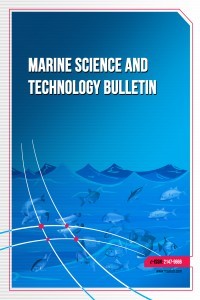
Marine Science and Technology Bulletin
Yazarlar: Quratulan AHMED, Sabri BİLGİN, Qadeer Mohammad ALİ
Konular:Denizcilik
DOI:10.33714/masteb.744301
Anahtar Kelimeler:Arabian Sea,Biological Stress,Seasonal Growth,Sea Cucumber
Özet: To estimate the growth parameters, the non-seasonal von Bertalanffy and Hoenig seasonal von Bertalanffy models were fitted to the length frequency data of Holothuria atra and H. arenicola obtained from coastal areas of Karachi in the northern Arabian Sea, Pakistan between January and December 2014. The Hoenig seasonal von Bertalanffy growth parameters were estimated as L∞=36.1 cm total length (TL), K=0.75 year-1 for H. atra and as L∞=34.9 cm TL, K=0.70 year-1 for H. arenicola. H. atra individuals reached 73.9% of their maximum total length at the one year old. For H. arenicola it was calculated as 72.7%. Monthly mean growth rate of H. atra at the same ages was calculated higher than H. arenicola. The seasonal oscillation in growth rate for H. atra (C=0.50) was larger than it was for H. arenicola (C=0.37). The time of the year when the growth is slowest corresponded to the middle of April (WP=0.30) in H. atra and at the beginning of August (WP=0.60) in H. arenicola may be the result of the extended both reproduction and poor nutrition periods due to monsoonal effects on the marine environment. The relatively high growth rates (K>0.7 year-1) of these two species may have important implications for high survival rate, particularly in environmental condition where cause biological stress and marine confusion but may also increase their potential as a candidate species for aquaculture.
Dergi editörleri editör girişini kullanarak sisteme giriş yapabilirler. Editör girişi için tıklayınız.